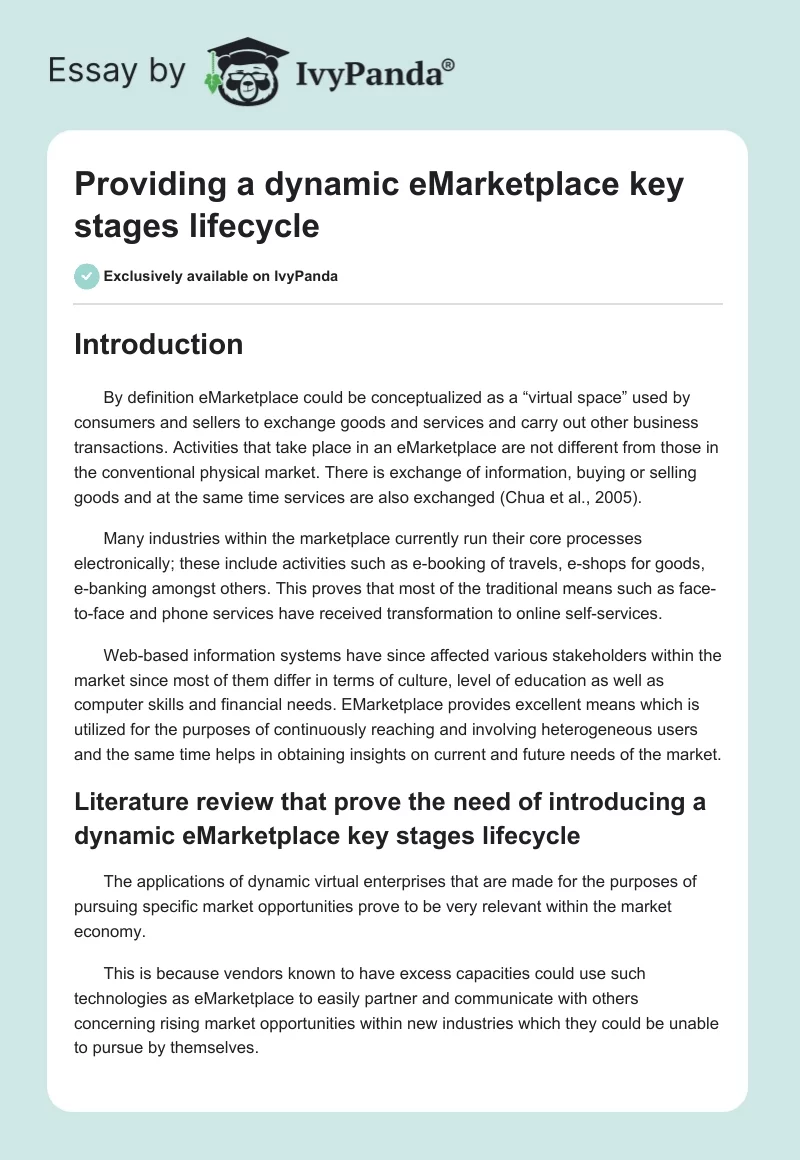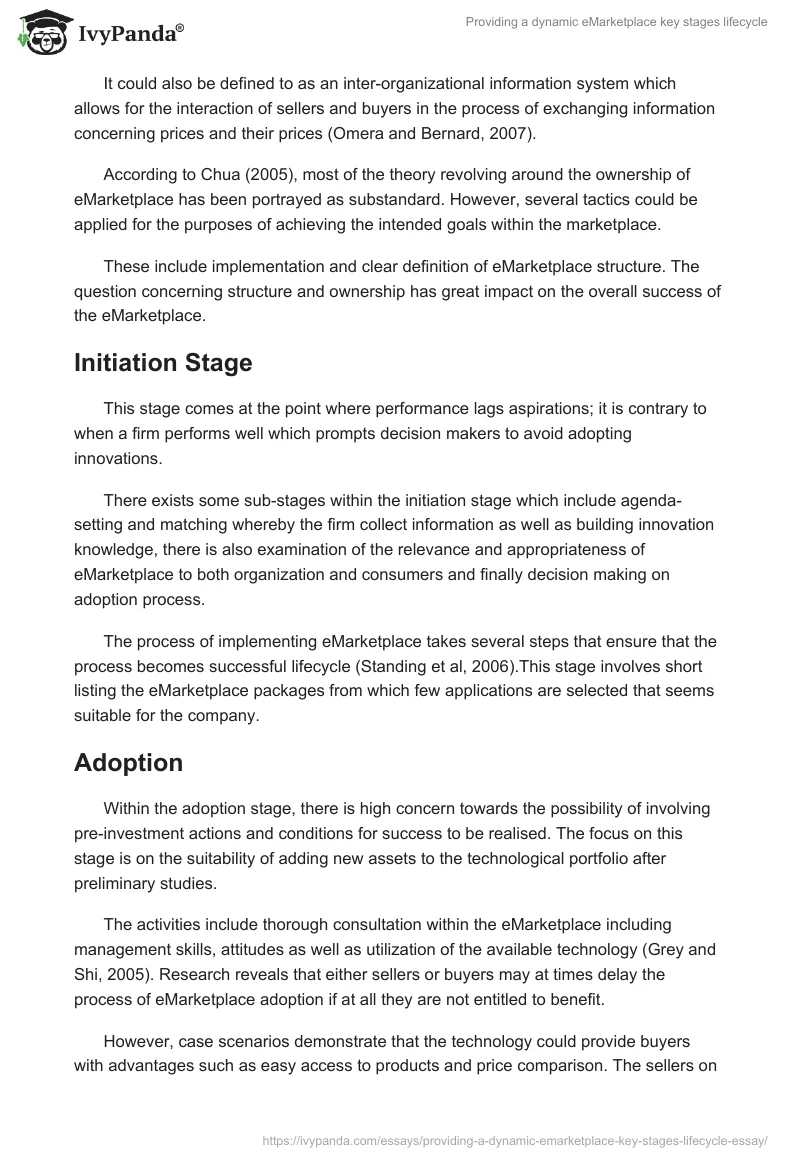Introduction
By definition eMarketplace could be conceptualized as a “virtual space” used by consumers and sellers to exchange goods and services and carry out other business transactions. Activities that take place in an eMarketplace are not different from those in the conventional physical market. There is exchange of information, buying or selling goods and at the same time services are also exchanged (Chua et al., 2005).
Many industries within the marketplace currently run their core processes electronically; these include activities such as e-booking of travels, e-shops for goods, e-banking amongst others. This proves that most of the traditional means such as face-to-face and phone services have received transformation to online self-services.
Web-based information systems have since affected various stakeholders within the market since most of them differ in terms of culture, level of education as well as computer skills and financial needs. EMarketplace provides excellent means which is utilized for the purposes of continuously reaching and involving heterogeneous users and the same time helps in obtaining insights on current and future needs of the market.
Literature review that prove the need of introducing a dynamic eMarketplace key stages lifecycle
The applications of dynamic virtual enterprises that are made for the purposes of pursuing specific market opportunities prove to be very relevant within the market economy.
This is because vendors known to have excess capacities could use such technologies as eMarketplace to easily partner and communicate with others concerning rising market opportunities within new industries which they could be unable to pursue by themselves.
It could also be defined to as an inter-organizational information system which allows for the interaction of sellers and buyers in the process of exchanging information concerning prices and their prices (Omera and Bernard, 2007).
According to Chua (2005), most of the theory revolving around the ownership of eMarketplace has been portrayed as substandard. However, several tactics could be applied for the purposes of achieving the intended goals within the marketplace.
These include implementation and clear definition of eMarketplace structure. The question concerning structure and ownership has great impact on the overall success of the eMarketplace.
Initiation Stage
This stage comes at the point where performance lags aspirations; it is contrary to when a firm performs well which prompts decision makers to avoid adopting innovations.
There exists some sub-stages within the initiation stage which include agenda-setting and matching whereby the firm collect information as well as building innovation knowledge, there is also examination of the relevance and appropriateness of eMarketplace to both organization and consumers and finally decision making on adoption process.
The process of implementing eMarketplace takes several steps that ensure that the process becomes successful lifecycle (Standing et al, 2006).This stage involves short listing the eMarketplace packages from which few applications are selected that seems suitable for the company.
Adoption
Within the adoption stage, there is high concern towards the possibility of involving pre-investment actions and conditions for success to be realised. The focus on this stage is on the suitability of adding new assets to the technological portfolio after preliminary studies.
The activities include thorough consultation within the eMarketplace including management skills, attitudes as well as utilization of the available technology (Grey and Shi, 2005). Research reveals that either sellers or buyers may at times delay the process of eMarketplace adoption if at all they are not entitled to benefit.
However, case scenarios demonstrate that the technology could provide buyers with advantages such as easy access to products and price comparison. The sellers on the other hand benefit from increased number of buyers, price discrimination and at the same time avoid information manipulation. EMarketplace adoption could be attributed to the rapid development of modern supply chain enabled through the internet.
Adoption of eMarketplace provides customers with various satisfactions involving provision of single point of contact hence simplifying the communication process, it strengthens buyer-supplier relationships, reduces cost and time in the purchasing process.
Implementation
Implementation stage represents the transitional period where the buyers and sellers within the eMarketplace undergo fresh training due to the effects by new innovations and at the end of it all commit themselves to its full applications. Implementation stage provides crucial link between the decisions made on adopting the application of eMarketing innovation and its later frequent applications.
The quality of analysis made during the adoption stage dictates the success of implementation processes. According to Standing and Lin, (2007) overall research should be basically guided by the relative importance of the different aspects of the process.
Diffusion
At the same time Hopkins and Kehoe (2007) focuses on the procurement diffusion processes practiced within eMarketplace. The diffusion stage involves differentiation of purchases into manufacturing as well as incorporation of inputs used in business operations.
According to the two authors, diffusion within the marketplace has got the capability of offering trading mechanisms which could be used to deal with the issues of overcrowded market environment.
Utilization
Within the utilization stage procurement done through eMarketplace could deliver higher returns to buyers and sellers. This is possible whenever companies realize and identify the right benefits associated with the technology and securing them quickly.
The participants in this stage undergo strategic diligence which precedes any business approach. This stage benefits the buyers and sellers on time and space, whereby the players take the shortest time possible to communicate.
Evaluation
In some cases eMarketplace utilization may have been approved by senior management ignoring the contributions by the operators and procurement professionals. The eMarketplace evaluation process should be at position of helping clients maximize their opportunities.
Each step during evaluation demands acquisition of information which is not easy to access. The technology is checked to establish its authenticity when used. Within this process the costs of implementation are justified against usage of eMarketplace (Gerow and Miller, 2010).
Improvement
Companies could improve their eMarketplace assessments by calculating the worth of enabling available technologies. Great value could be achieved by accessing seamless site-resident supply chain planning tools, design-collaboration tools and formation systems.
However, not all businesses are equally ready to utilize eMarketplace opportunities, this calls for incorporation of discrete project step which would help assess internal readiness as well as develop sequenced plan for building new organizational strengths.
The growth in high-technology programs such as eMarketplace and enterprise resource planning for shows that the technology is an important factor for general enterprise applications.
EMarketplace serves as a back-end application by linking suppliers, manufacturers, distributors, and resellers in a consistent production and distribution network, with the IT industry regulating the ability of a variety of services over time (Lages et al., 2005).
Prove positively the need of using the notion dynamic in the topic
The notion dynamic has been used to signify the fact that e-marketing in its deeper sense offer more viable and sustainable business models providing good grounds for organizations operations and participation. At the same time most of the literature concerning eMarketplace has not been able to thoroughly examine and address some implications within eMarketplace domain and structures (Standing and Lin, 2007).
The eMarketplace structures are known to be little more complex and at the same time dependant on the kind of business strategies implemented by the market makers (John et al, 2006).
The rapid changes experienced within the competitive market environment calls for use and application of modern techniques such as EMarketplace systems. The system supports improvements in sales and buying processes within the marketplace as well as reduction in cost of production and quality related problems.
EMarketplace systems help in improving management- customer relationship by providing quality and convenient services (Lacastre and Lages, 2006). It makes it easier for customers to transact business online like purchasing products and enquiring about products.
Enterprise, Resource and Planning used within EMarketplace facilitate faster links, distribution and analysis of data information (Nissen and Sengupta, 2006; Bleistein et al, 2006). This makes it easier when it comes to co-ordinations amongst players within the market environment as well as management of production and sales within business organizations.
Conclusively, it changes the manner in which business is carried out individually and at organization’s level. It leads to changes in business activities and individual work systems (Autry and Bobbitt, 2008).
Companies operating within the national and global markets operate under some central management which assists in attesting the robustness and importance of supply chain management within eMarketplace based on its extraordinary growth.
EMarketplace comprises of various activities taking place within organization’s operations, marketing management, economics, logistics and information systems (Driedonks et al, 2005). All these are relevant towards the success of business within the market environment.
Table that summarizes at least 7 key papers that used to provide the dynamic lifecycle
Conclusion
As shown in the discussion the structure of eMarketplaces considers a number of implications which ultimately determines the success of the eMarketplace. However, there have been several cases of perceived bias which could be addressed by improving on the level of transparency within the eMarketplace. This helps in identifying prospective participants which ultimately develops high levels of trust.
Logistics within the eMarketplace presents one of the determinants of corporate programs. The element of logistics is used in exercising leadership roles and at the same time assists in the realignment of personal logistics with the company’s corporate plans.
EMarketplace majorly focuses on developing processes which ultimately responds to consumers and suppliers general requirements. Previously, it was the duty of the suppliers to determine and dictate on the processes of reaching customers with goods and services. This is contrary to modern times owing to the utilization of eMarketplace system which enables buyers and sellers to interact freely and within the shortest time possible.
References
Autry, C. W., & Bobbitt, M., L. 2008. Supply Chain Security orientation: Conceptual Development and a proposed framework. International Journal of Logistics Management, 19(1), pp 42-64.
Bleistein, J., Karl Cox, K., Verner, J. K., & Phalp, K., 2006. Requirements Engineering for e-business advantage. Springer London, 11(1), pp 4-16
Chua, C., Khoo, H., Straub, D., Kadiyala, S., & Kuechler, D. 2005. The Evolution of e Commerce Research: A stakeholder perspective. Journal of electronic Commerce Research, 6 (4), pp 262-280
Driedonks, C., Gregor, S., Wassenaar, A. & van Heck, E., 2005. Economic and Social Analysis of the Adoption of B2B Electronic Marketplaces: A case Study in
The Australian Beef Industry. International Journal of Electronic Commerce, 9(3), 49-72
Grey, W., & Shi, D. 2005. The Role of eMarketplaces in relationship-based Supply Chains: A survey. IBM Systems journal, (44), pp 109-123
Hopkins, J. L. & Kehoe, D.F. 2007. Testing an Interrelationship Matrix-based method Designed for Assisting in eMarketplace Selection. Electronics Markets, (17), pp 210-230
John, S., Caroline, E., Godsell, J. Harrison, A. 2006. Supply chain Management: theory, practice and future challenges. International Journal of Operations Production Management, 26 (7), pp 754-774.
Kim, Young-Gul & Joo, Y. 2004. Determinants of corporate adoption of eMarketplace: An innovation theory perspective. Journal of Purchasing and Supply Management, (10), 89-101
Lacastre, A., & Lages, L. F. 2006. The relationship between buyer and a B2B e Marketplace: Cooperation determinants in an electronic market context. Industrial Marketing Management, (35), pp 774-789
Lages, C., Lages, C. R., & Lages, L. F. 2005. The RELQUAL scale: A measure of Relationship quality in export market ventures. Journal of Business Research, (58), pp 1040-1048
Nissen, M. E. & Sengupta, K., 2006. Incorporating Software Agents into Supply Chains: Experimental Investigation with a Procurement Task. MIS Quarterly, 30(1), 145
Omera, K., & Bernard, B., 2007. Risk and supply chain management: creating a Research Agenda. The International Journal of Logistics Management, 18 (2), pp 197 – 216
Standing, C. & Lin, C., 2007. Organizational Evaluation of the Benefits, Constraints, And Satisfaction of Business-to-Business Electronic Commerce, International. Journal of Electronic Commerce, 11(3), pp 107-135.
Standing, C., Love, P.E., Stockdale, R., & Gengatharen, D., 2006. Examining the Relationship between Electronic Marketplace Strategy and Structure. IEEE Transactions on Engineering Management, 53 (2), pp 297-309


